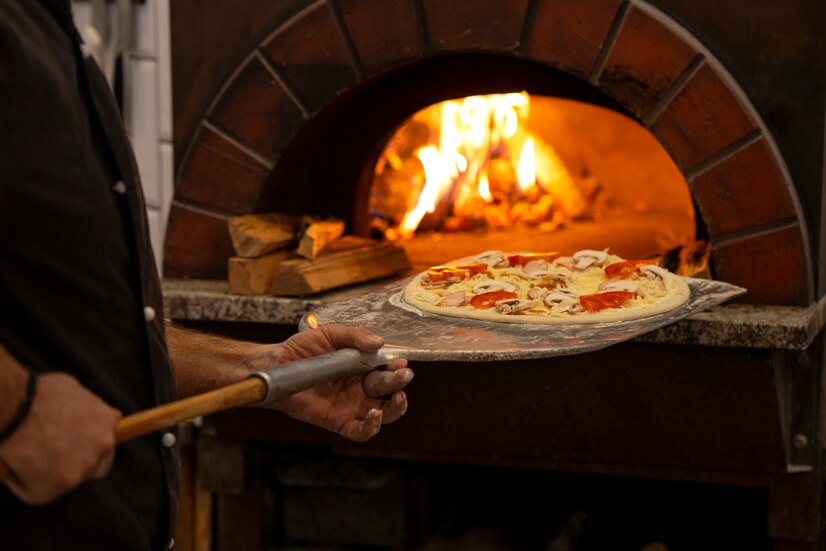Wood-fired pizza has become a celebrated culinary delight, beloved for its unique flavor, texture, and authenticity. The transformation from simple dough to a delectable, crispy, and aromatic pizza involves a blend of art and science.
Understanding the science behind wood-fired pizza not only enhances the appreciation of this culinary craft but also helps in perfecting the process. This article delves into the intricacies of wood-fired pizza, exploring the key elements that contribute to its exceptional taste and texture.
The Basics of Wood-Fired Pizza
Wood fired pizza scottsdale is known for its distinct characteristics: a crispy crust, a smoky flavor, and perfectly melted toppings. These attributes result from the high temperatures and unique cooking environment of a wood-fired oven. To fully grasp the science behind this pizza, we must start with the basics: the dough, the oven, and the cooking process.
The Dough: Foundation of a Perfect Pizza
The dough is the heart of any pizza, and in wood-fired pizza, it plays an even more crucial role. The dough for wood-fired pizza typically consists of four main ingredients: flour, water, yeast, and salt. Let’s break down the science behind each component.
Flour
- Type of Flour: High-protein flour (often labeled as bread flour) is preferred for wood-fired pizza dough. The higher protein content leads to more gluten development, providing the necessary elasticity and chewiness.
- Gluten Formation: Gluten, a network of proteins, is essential for the dough’s structure. The kneading process aligns these proteins, creating a stretchy, elastic dough that can trap gas bubbles produced during fermentation.
Water
- Hydration Level: The water-to-flour ratio (hydration level) significantly affects the dough’s texture. Higher hydration levels (around 65-70%) yield a softer, more pliable dough, ideal for wood-fired pizza.
- Temperature: Lukewarm water (around 95°F or 35°C) is ideal for activating yeast without killing it.
Yeast
- Fermentation: Yeast ferments the sugars in the flour, producing carbon dioxide and ethanol. The carbon dioxide forms bubbles in the dough, making it rise and creating a light, airy texture.
- Flavor Development: Fermentation also produces organic acids and alcohols, contributing to the dough’s complex flavor.
Salt
- Flavor Enhancer: Salt enhances the dough’s flavor and regulates yeast activity, preventing over-fermentation.
- Gluten Strength: Salt strengthens the gluten network, improving the dough’s elasticity and texture.
The Wood-Fired Oven: Creating the Ideal Environment
A wood-fired oven is not just a cooking appliance; it’s an integral part of the pizza-making process. The design and function of the oven create the optimal conditions for baking a perfect pizza.
High Temperatures
- Heat Retention: Wood-fired ovens can reach temperatures between 800°F and 900°F (427°C and 482°C). The thick, refractory material of the oven retains and radiates heat uniformly.
- Rapid Cooking: These high temperatures cook the pizza in just 90-120 seconds, ensuring a crispy crust while keeping the toppings fresh and flavorful.
Radiant and Convection Heat
- Radiant Heat: The dome of the oven radiates intense heat, cooking the top of the pizza quickly.
- Convection Heat: The fire creates airflow within the oven, circulating hot air and ensuring even cooking.
Wood as Fuel
- Type of Wood: Hardwoods like oak, maple, and hickory are preferred for their high heat output and consistent burn.
- Smoke Flavor: Wood combustion produces aromatic compounds that infuse the pizza with a unique smoky flavor.
The Science of Dough Fermentation
Fermentation is a crucial stage in pizza dough preparation. It involves the biochemical transformation of the dough, significantly impacting its texture and flavor. Understanding the fermentation process helps in mastering wood-fired pizza dough.
Yeast Activity
- Primary Fermentation: When yeast is mixed with flour and water, it begins to consume sugars and produce carbon dioxide and ethanol. This initial fermentation phase creates the dough’s airy structure.
- Secondary Fermentation: A prolonged fermentation period (cold fermentation) allows the dough to develop a more complex flavor profile. This process can take up to 72 hours and occurs at lower temperatures (around 39°F or 4°C).
Enzymatic Reactions
- Amylase Activity: Enzymes like amylase break down starches into simple sugars, which yeast then ferments. This process enhances the dough’s sweetness and browning during baking.
- Protease Activity: Proteases break down proteins, improving dough extensibility and reducing elasticity, making it easier to stretch and shape.
Flavor Development
- Organic Acids: Fermentation produces organic acids like lactic and acetic acid, contributing to the dough’s tangy flavor.
- Alcohols and Esters: These compounds add depth to the dough’s flavor, creating a complex and satisfying taste profile.
The Baking Process: From Dough to Done
The transition from raw dough to a finished pizza involves several scientific principles working in harmony. The high heat, rapid cooking time, and unique environment of a wood-fired oven all play critical roles.
Heat Transfer Mechanisms
- Conduction: The hot oven floor transfers heat directly to the dough, creating a crispy crust.
- Radiation: The dome radiates heat, cooking the toppings and the top of the dough quickly.
- Convection: Hot air circulates around the pizza, ensuring even cooking.
Maillard Reaction
- Browning: The Maillard reaction, a chemical reaction between amino acids and reducing sugars, occurs at high temperatures. This reaction is responsible for the pizza’s golden-brown crust and complex flavors.
- Temperature Threshold: The Maillard reaction begins around 280°F (140°C) and accelerates at higher temperatures, typical in wood-fired ovens.
Steam and Crispiness
- Moisture Evaporation: As the dough heats up, moisture evaporates from its surface, creating steam. The high oven temperature ensures that this steam escapes quickly, leading to a crispy crust.
- Crust Formation: The rapid loss of moisture, combined with intense heat, forms a thin, crispy outer layer while keeping the interior soft and airy.
Cheese and Toppings
- Cheese Melting: Cheese melts at relatively low temperatures (around 130°F or 54°C), and the radiant heat from the oven dome ensures even melting without burning.
- Topping Interaction: The high heat slightly caramelizes toppings like vegetables and meats, enhancing their flavors without overcooking them.
The Art of Perfecting Wood-Fired Pizza
While understanding the science behind wood-fired pizza is crucial, perfecting this art also requires practice, experience, and a few practical tips.
Dough Preparation Tips
- Proper Kneading: Knead the dough until it is smooth and elastic, usually around 10-15 minutes.
- Fermentation Time: Allow sufficient fermentation time to develop flavor. A minimum of 24 hours of cold fermentation is recommended.
- Dough Handling: Handle the dough gently to preserve the gas bubbles formed during fermentation.
Oven Management Tips
- Preheating: Ensure the oven is thoroughly preheated to the desired temperature, usually taking about an hour.
- Fire Management: Maintain a consistent fire using hardwood logs, adding small amounts of wood periodically to sustain the temperature.
- Oven Floor: Use a pizza peel to rotate the pizza for even cooking, and ensure the oven floor is clean to prevent burning.
Baking Tips
- Stretching the Dough: Stretch the dough evenly to avoid thin spots that can burn quickly.
- Topping Balance: Avoid overloading the pizza with toppings to ensure even cooking and prevent a soggy crust.
- Baking Time: Monitor the pizza closely, as wood-fired ovens cook quickly. The pizza is usually done in 90-120 seconds.
Conclusion
Wood-fired pizza is a harmonious blend of science and artistry. From the careful selection and preparation of the dough ingredients to the precise management of the oven’s heat and the rapid baking process, each step is crucial in creating a perfect pizza. By understanding the scientific principles behind dough fermentation, heat transfer, and flavor development, enthusiasts can elevate their pizza-making skills and fully appreciate the complexities involved. Whether you’re a professional chef or a home cook, mastering the science of wood-fired pizza will undoubtedly lead to delicious and satisfying results every time.



